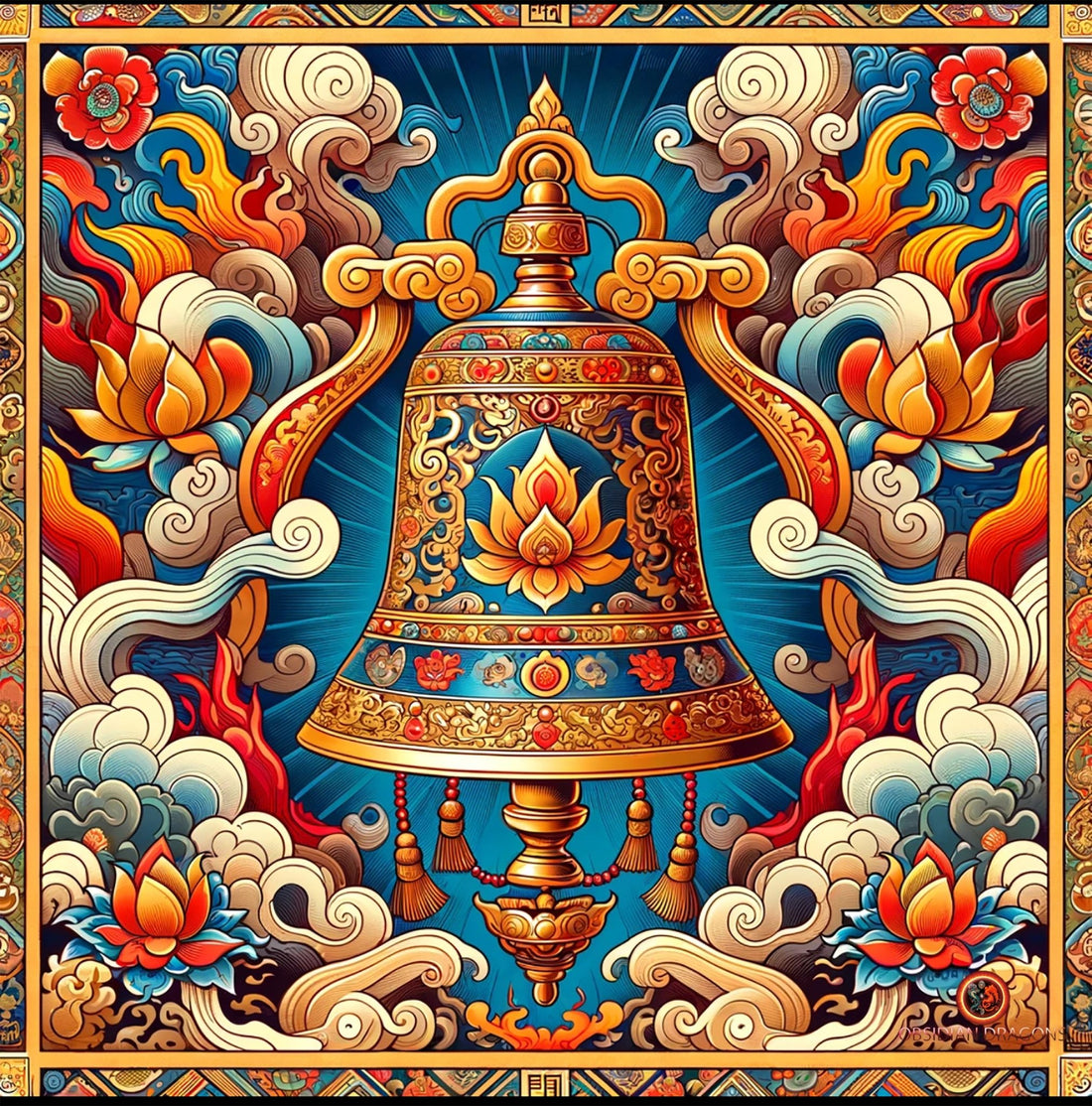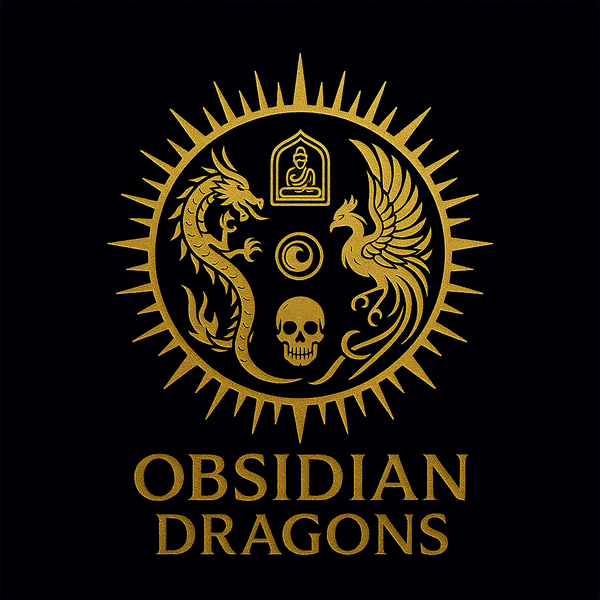
The Drilbou - Tibetan Bell - Buddhist Symbol of Wisdom
Share
Vajrayana Buddhism, and its tantric form, is rich in symbols and rituals that help practitioners connect more deeply with their spiritual path. Among these symbols, the drilbu, or Tibetan bell, occupies a central place. But what does the drilbu actually represent and how is it used in spiritual practices?
1- What is the Drilbou or Tibetan bell?
The drilbou is a ritual bell, symbolizing wisdom, emptiness and purification.
Used in tandem with the vajra (or dorje), a scepter that symbolizes lightning and indestructibility. Together, these objects represent the union of the feminine and masculine aspects, of wisdom and method, essential to achieving enlightenment.
A) Origin of drilbou
The drilbou, also known as the Tibetan bell, has origins deeply rooted in the spiritual traditions of Vajrayana Buddhism, also known as Tibetan Tantric Buddhism.
Here are some key points about its origin and development:
Indian Origins : The drilbu, like many other elements of Vajrayana Buddhism, has its origins in ancient India. It is derived from the ritual bells used in Hindu and Buddhist practices to mark transitions in rituals and meditations.
Introduction to Tibet : Drilbu was introduced to Tibet with the arrival of Tantric Buddhism in the 7th century. Tantric practices were widely adopted and adapted by Tibetans, incorporating local and pre-Buddhist elements of Tibetan culture.
Drilbu, along with many other elements of Vajrayana Buddhism, were introduced to Tibet by Indian Buddhist masters and scholars such as Padmasambhava ( Guru Rinpoche) or Shantarakshita.
With the arrival of these masters, ritual practices using instruments such as the drilbou were integrated into Tibetan religious and shamanic ceremonies.
These practices included the use of the drilbu and vajra to symbolize wisdom and method, essential elements in rituals of purification, initiation, and meditation.
Tibetan Evolution : In Tibet, the drilbu evolved into an essential ritual instrument in religious practices. It is often used in tandem with the vajra (dorje), representing wisdom and method (or compassion), respectively, two essential aspects of the path to enlightenment in Buddhism.
Symbolism : The drilbu has become a powerful symbol of wisdom and emptiness (shunyata) in Tibetan Buddhism. Its use in rituals is intended to remind practitioners of the impermanent and empty nature of all phenomena, thus promoting meditation and spiritual purification.
Manufacturing and Craftsmanship : The making of the drilbu involves specialized craftsmanship. Traditionally, it is made of metal alloys, often with intricate decorations and engraved symbolic designs. The bell and accompanying vajra are often passed down from master to disciple, symbolizing the transmission of wisdom and spiritual teachings.

B) What is the symbolism of the drilbou? The Tibetan bell
- Wisdom: The bell represents wisdom. In Buddhism, wisdom is the deep understanding of emptiness (shunyata), the ultimate, non-dual nature of all phenomena. The sound of the bell symbolizes this penetrating wisdom that sees through the true nature of reality.
- Emptiness : The sound of the drilbou is ephemeral and resonant, reminding us of the emptiness of all phenomena. Just as the sound of the bell quickly disappears, all phenomena are impermanent and devoid of intrinsic existence. This constant reminder helps practitioners to detach themselves from the illusions of the material world.
- Union of Opposites : The drilbou is often used with the dorje . The bell, representing wisdom, and the dorje , symbolizing method or compassion, together embody the union of these two essential aspects of the spiritual path. This union is fundamental to Buddhist practice, because wisdom without compassion is sterile and compassion without wisdom is blind.
To learn more about this subject, I invite you to consult my article, "how to use the dorje and the Tibetan bell in Buddhist practice", by clicking on this link
- Purification : The sound of the drilbou is considered purifying. It helps to dispel negative thoughts and mental obscurations, thus creating a state of mind conducive to meditation and spiritual practice.
2- Compositions and symbolism of each part composing a drilbou

Here is the symbolism of each part of a drilbou, the Tibetan bell:
- Crocodiles (compassion):
Crocodiles on a drilbou symbolize compassion, an essential aspect of Buddhist practice. They represent protection and the ability to navigate the turbulent waters of existence with wisdom and compassion.
- Wisdom face/ Face of wisdom (Prajnaparamita/Yidam)
The face of wisdom on a Tibetan bell represents Prajnaparamita, the personification of the perfection of wisdom. It symbolizes ultimate knowledge and enlightenment.
- 6 rings/ 6 rings (6 perfections)
The six rings of the drilbou represent the six perfections or paramitas: generosity, ethics, patience, enthusiastic effort, concentration and wisdom. These qualities are essential for progressing on the path to awakening.
- 8 Goddesses (seed syllabus)
The eight goddesses of the Tibetan bell represent the seed syllables of mantras and symbolize the various divine energies used in tantric practices for spiritual transformation.
- Symbol according to Buddha family (Vajra jewels)
Each symbol on the drilbou represents a different Buddha family, each with its own spiritual qualities and aspects. The Vajra jewels represent the indestructibility and clarity of ultimate reality.
- Silk Banner (enlightened activity)
The silk banner represents the enlightened activities and beneficial actions of Buddhas and Bodhisattvas, spreading wisdom and compassion to the world.
- Lotus womb/Lotus belly
The belly of the lotus symbolizes purity and rebirth. It also represents the matrix of creation and the pristine nature of the mind.
- Disk of Space (Emptiness)
The space disc on the Tibetan bell symbolizes emptiness, the understanding that all phenomena are empty of intrinsic nature. It is a central concept in Buddhism for realizing the ultimate nature of reality.
- Vajra crown (embodiment of the five buddhas)
The Vajra crown on the drilbou embodies the five wisdom buddhas, representing the five wisdoms that purify the five main negative emotions.
- Lotus of the Vajra crown/Lotus of the Vajra crown
The Vajra crown lotus symbolizes purity and spiritual awakening. It also represents spiritual fulfillment and liberation.
- Longevity vase of nectar / Longevity nectar vase
The longevity nectar vase symbolizes immortality and healing. It is often used in rituals to bless and prolong life.
- Lotus throne of Mandela deity: Lotus throne of Mandela deity
The lotus throne on the drilbou represents purity and spiritual elevation. It also symbolizes the seat of the deities in mandalas and tantric practices.
- 8 Bodhisattvas (petals)/ 8 Bodhisattvas (petals)
The eight Bodhisattva petals on the Tibetan bell represent the eight great bodhisattva figures who embody compassion and wisdom in Buddhism.
- 16 Vajras (offering Goddesses)
The 16 Vajras represent the goddesses of offerings, symbolizing the various energies and qualities offered to the Buddhas and Bodhisattvas.
- 8 faces of glory / 8 faces of glory
The eight faces of glory of the drilbou symbolize the different manifestations of enlightenment and divine wisdom.
- Earth Disk/ Earth Disk
The earth disc of the Tibetan bell symbolizes stability and a solid foundation for spiritual practice. It also represents the earth element in mandalas.
- Vajra fence/ Vajra fence
The Vajra/Dorje shaped drilbou enclosure symbolizes protection and delimitation of sacred space, protecting against negative influences.
- Necklace of light/ Necklace of light
The Tibetan Bell Light Necklace represents the clarity and radiance of spiritual wisdom, illuminating the path to awakening.
These elements, each rich in symbolism, constitute the Vajra bell, a powerful and sacred tool in Buddhist tantric rituals.
3- Conclusion
The drilbou, or Tibetan bell embodies the profound principles of wisdom and emptiness, essential in the path of Vajrayana Buddhism. Its use, in tandem with the vajra, symbolizes the union of the feminine and masculine aspects, of wisdom and method, recalling the importance of balance and harmony in the quest for enlightenment.
Each element of the drilbu, from the crocodiles of compassion to the rings of perfection to the face of Prajnaparamita's wisdom, carries rich and powerful symbolism that guides practitioners on their spiritual journey. Throughout the ages, the drilbu has evolved, incorporating cultural and spiritual influences, to become an indispensable tool in rituals of purification, meditation and initiation.
By understanding and honoring the symbols and traditions associated with the drilbu, practitioners can connect more deeply with their spiritual practice, finding the peace, harmony, and wisdom needed to navigate the challenges of modern life. Whether used in religious ceremonies or as a daily reminder of wisdom and compassion, the drilbu continues to play a vital role in Tibetan Tantric Buddhism, inspiring and guiding truth seekers toward ultimate enlightenment.
